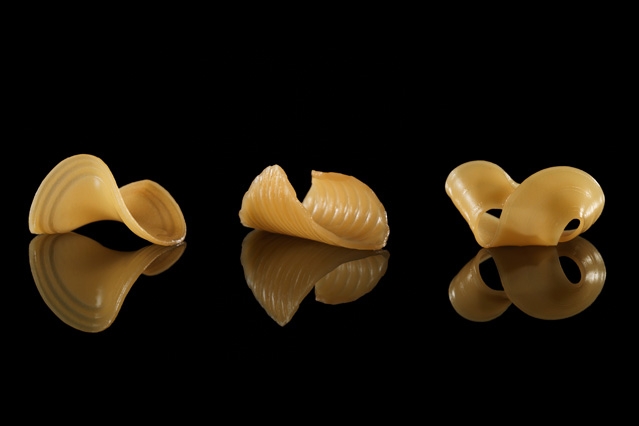MIT plays with food and makes edible “origami”
For those looking for a unique dining experience, MIT has just the right thing. Scientists produced an edible filament that changes its shape in contact with water and it can be used to make some incredible dishes.
Scientists from MIT’S Tangible Media Group came up with edible origami. The researchers successfully produced flat sheets of gelatin and starch that change their shapes when submerged in water. The filament transforms into 3D structures, including popular forms like pasta.
And the scientists went even further in their effort to make dining even more fun. The edible film can also be constructed to develop more complex shapes, like flowers and even unconventional configurations.
Researchers say that the edible shape-shifting food will not only help chefs create more intricate dishes but could also potentially save packaging and in consequence shipping costs, scientists say. The sheets could be easily packaged and consumers could just add water to make them regain their 3D forms.
For example, the sheets could be used to wrap around pieces of caviar, scientists say, or be made into spaghetti which spontaneously divide into smaller noodles when dunked in hot broth.
“We did some simple calculations, such as for macaroni pasta, and even if you pack it perfectly, you still will end up with 67 percent of the volume as air,” says Wen Wang, a co-author on the paper and a former graduate student and research scientist in MIT’s Media Lab. “We thought maybe in the future our shape-changing food could be packed flat and save space.”
Programming shapes and structures
The idea of shape shifting food came after Wang and Lining Yao, lead author and former graduate student, worked on bacteria that could change their shape and size in response to changes in humidity. The same bacteria they found that could shrink and expand, is present in ferment soybeans used by the Japanese to prepare natto, a traditional breakfast dish, usually served with soy sauce.
The scientists wondered if they could come up with a material that changes its shape, just like the bacteria, one in contact with water. They took gelatin into account as the substance that naturally expands when it absorbs water, with the changes depending on its own density.
They started experimenting with density and ended up in constructing a film that contains two layers of gelatin of different densities. Since the upper layer is denser, it can absorb more water, and the film starts to curl.
Now scientists looked it they could create predictable shapes out of their films and ended up 3D printing a layer of cellulose over the gelatin sheets. The cellulose acts as a barrier, controlling the amount of water that can be absorbed and the team found that they could determine certain shapes with the help of the 3D printed cellulose.
“This way you can have programmability,” Yao says. “You ultimately start to control the degree of bending and the total geometry of the structure.”
This is how scientists ended up creating shapes like macaroni, flowers or even horse saddles, just by controlling the degree of bending.
From the lab, to the kitchen

The next logical step was to test their creation in restaurant settings and a head chef of a high-end Boston restaurant was quick to try out the new edible “origami”.
This is how the scientists were able to try out transparent discs of gelatin flavoured with plankton and squid ink, that instantly wrap around small beads of caviar; and long fettuccini-like strips, made from two gelatins that melt at different temperatures, causing the noodles to spontaneously divide when hot broth melts away certain sections.
“They had great texture and tasted pretty good,” Yao says.
The team recorded the cellulose patterns and the dimensions of all of the structures they were able to produce, and also tested mechanical properties such as toughness, organising all this data into a database. Two other co-authors of the paper, Chin-Yi Cheng, a former graduate student and Teng Zhang of Syracuse University, design an online interface for users to design their own edible, shape-transforming structures.
“We did many lab tests and collected a database, within which you can pick different shapes, with fabrication instructions,” Wang says. “Reversibly, you can also select a basic pattern from the database and adjust the distribution or thickness, and can see how the final transformation will look.”
The team believes that this will help people create their own noodles and a start-up could have the products delivered to them, and, in their own word, noodle design will be a democratic process.